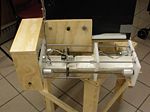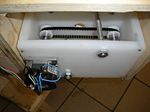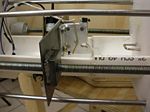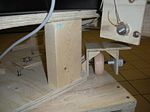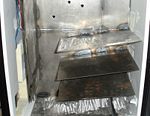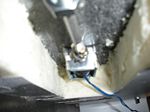Can Launching Fridge
Overview
The can launching fridge is a fully automated and self contained unit designed to dispense and throw a can to a predetermined location when commanded by the user. The concept was inspired by a project done by John W. Cornwell of Duke University.
Team Members
- Derek Siegal (Mechanical Engineering, Class of 2010)
- Chris Semple (Mechanical Engineering, Class of 2011)
- Leland Gossett (Biomedical Engineering, Class of 2011)
Mechanical Design
Our design consists of three main components in addition to the refrigerator: a rotating base and stand, a launcher assembly, and an internal magazine for dispensing cans. It was decided early in the design process that we preferred a spring powered linear launch mechanism to the catapult system employed by the example mentioned above. This was for several reasons. Most importantly, this system allows for control of three parameters – launch direction, elevation angle, and power – for precise tuning and variability of the launch sequence.
Launcher Assembly
The launcher assembly is built around a polyethylene front plate connected by four steel guide rods to a box in the rear that serves as a motor mount and housing for a timing belt drive. This motor, in our case a **INSERT MOTOR SPECIFICS** stepper motor was used to turn two lead screws that run parallel and outside of the guide rods. A steel carriage plate is threaded onto these lead screws to create a linear drive capable of running the length of the assembly. In order to get smooth and reliable motion from the lead-screw drive, the alignment of the carriage had to be adjustable and the rotation had to be unimpeded. This was accomplished by machining aluminum couplers that were 3/8” - 16 threaded female on one end and exposed 1/4” rod on the other to insert into bearings. This allowed for the threaded rods to be threaded into or out of the couplers for alignment purposes, while still maintaining a constant available length. Under this was suspended half of a PVC pipe that supports the can to be launched. Finally, a launch plate is mounted on the guide rods such that it can slide freely over the pipe and these rods in the direction of launch. In action, the carriage brings forward a trigger which locks onto the rear of the launch plate. Having done so, it retracts a preset distance to store energy in the springs, and finally releases the trigger to launch the can.
Triggering the Launch Plate/Firing the Can
Controlling the Launch Angle
The whole launch assembly is mounted to the side of the refrigerator with a rear pivot point to allow cans to be gravity fed into the top of it. The launch angle is adjusted by angling this whole assembly upwards with a winch mounted on the top of the refrigerator. Though the motor for this winch was also a stepper motor, we decided to use a potentiometer for positional feedback to prevent accumulation of error through subsequent runs.
Controlling the Direction
Next, a system was needed to aim the direction of launch. This is accomplished in our design by mounting the entire refrigerator on top of a turntable. This consists of a Lazy Susan bearing bolted between two plates. The first of which was bolted to the bottom of the refrigerator, while the second was elevated off the ground by a wooden frame to help reduce power required for reasonable launch trajectories. Rotation was achieved by a friction wheel driven by a small DC motor attached to the outside of the turntable plate. As with the launcher assembly, position was determined by coupling a potentiometer between the two plates.
The Magazine
Finally, a magazine was built to feed cans into the launching tube. Placing a premium on capacity, we decided to utilize a gravity fed system essentially consisting of parallel angled plates that act as shelves for cans to rest on as they progressively feed towards an opening cut out of the refrigerator wall. All of the upper plates were cut shorter than the bottom-most one, so that a space is left for cans to roll onto the lowest plate and eventually out the opening. This magazine was welded together out of plate steel, and features a two stage loading gate. The first uses a relatively powerful and long draw solenoid that is able to overcome the friction inherent in supporting the weight of a full magazine of cans, while the second is much lighter and is positioned at the opening for the final release. This design was motivated by two considerations: first, that a single gate system would require significant tuning to time the release of only a single can, and second, that cans would potentially feed at different speeds depending on the amount of cans loaded at any given point. By using a two stage system, only enough space is permitted for one can to roll past stage one while it is open, and once stage two opens, the can will be released from a consistent distance to prevent irregularities in the sequence.
